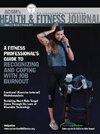Current Perspectives About Scope of Practice
IF 1.6
4区 医学
Q3 SPORT SCIENCES
引用次数: 0
Abstract
Current Perspectives About Scope of Practice Irecently attended the annual meeting for the Institute for Credentialing Excellence (ICE) in San Antonio. This is the organization that encompasses the National Commission for Certifying Agencies that accredits ACSM certifications. The issue of scope of practice was addressed at one session, and the following are some important points to take home in our profession. ACSM currently has a credentialing board, the Committee of Certification and Registry Boards, which has established the basics of who can be certified, how they are examined, and grants a certification based on an examination prepared from a Job Task Analysis. Often, the basis of forming a regulatory board in a state is based on the certification board’s standards. For some time now, there have been calls frommany certifiedmembers stating that we need licensure to stand our ground. However, we must be cautious as we pursue licensure because it truly is not the ‘‘holy grail’’ with respect to ensuring security for exercise professionals. There are a number of reality checks that must be considered with regard to licensure. First, licensure is granted at the state level; therefore, it would take an organized state effort for this process to begin. Second, as with many professions, the regulation of the profession would likely differ from state to state and there are never any guarantees that a bill will ever pass and be signed into law. Other factors to consider include the securing of two or three legislators who will sponsor the proposed bill for legislation and move the bill into a committee. The additional challenge to having a bill advance is countering the objections that other groups or professions may have against the proposed legislation. Opposing groups often hire lobbying firms who monitor legislative efforts and, when alerts come forth, register objections throughout the process. This can add many delays to getting a bill to the floor and voted on. In addition, there is a difference between the law itself, which is the legislation, and the regulations (parameters of practice), which follow if the bill is passed. The law becomes the practice act. However, a trend today is to see legislators writing language into the bill (sometimes during floor debate) that becomes regulatory in nature. This process can become problematic in the future. If, for example, the Job Task Analysis suggests changes in what a profession does, and those parts are actually written in the law, then a new law must be written and changed by most likely a new set of legislators. Therefore, it is best to have the law written with the regulatory issues determined by an established board that oversees the practice act. More desirable is to have the law written to establish a regulatory board. Then the board becomes the authority to write the regulatory statutes for the profession. Most license laws address: • Who is to be licensed? • Who is the authority to oversee the profession? • Establishes a board of advisors. •Grants authority to write regulations. • Grants authority to issue, suspend, or revoke credentials. State regulation may not always imply a ‘‘license’’ to practice. Some states, which have regulatory practice acts of a profession, may grant a license, which is most restrictive. However, other states may grant a certification or a registry for the same profession. The least restrictive level of regulation is trademark protection. The North American Registry of Midwives credential is the Certified Professional Midwife. Currently, only 28 states regulate this profession, and of those, 17 are actually ‘‘licenses’’ to practice. The same variances are seen in exercise-related professions. Currently, physical and occupational therapies are regulated in all 50 states, 49 states regulate athletic training, and 46 regulate registered dieticians. However, each state varies for each profession whether it’s a license or other form of regulation. Another consideration is the issue of the regulatory board. Once a law is passed, then a board must be established to oversee the credential. This, as everything in life, must be funded. Thus, the ACSM Certification关于实践范围的当前观点
我最近参加了在圣安东尼奥举行的卓越资格认证协会(ICE)年会。这个组织包含了认可ACSM认证的国家认证机构委员会。在一次会议上讨论了实践范围的问题,以下是我们这个行业需要牢记的一些要点。ACSM目前有一个资格认证委员会,即认证和注册委员会委员会,该委员会确定了谁可以获得认证、如何进行认证的基本原则,并根据工作任务分析准备的考试授予认证。通常,在一个州组建监管委员会的基础是基于认证委员会的标准。一段时间以来,有许多认证会员打电话说我们需要执照来坚持我们的立场。然而,我们在追求执照时必须谨慎,因为它确实不是确保运动专业人员安全的“圣杯”。关于许可证,必须考虑许多现实检查。首先,执照是在州一级颁发的;因此,这一进程需要有组织的国家努力才能开始。其次,与许多职业一样,该行业的监管可能因州而异,而且从来没有任何保证法案会通过并签署成为法律。另外还需要考虑的是,确保2 ~ 3名议员提出立法提案,并将法案提交给委员会。推动法案的另一个挑战是应对其他团体或专业可能对拟议立法的反对意见。反对团体经常雇佣游说公司来监督立法工作,当警报出现时,在整个过程中登记反对意见。这可能会给议案的提交和投票增加许多延误。此外,法律本身(即立法)与法案通过后随之而来的法规(实践参数)之间也存在差异。法律成为实践行为。然而,今天的一个趋势是,立法者在法案中(有时是在辩论中)写一些具有监管性质的语言。这个过程在将来可能会成为问题。例如,如果《工作任务分析》建议改变某一职业所做的工作,而这些部分实际上已经写进了法律,那么很可能就必须由一组新的立法者来编写和修改一部新的法律。因此,最好是将法律与监管问题写在一起,由一个监督实践行为的既定委员会确定。更可取的做法是制定法律,建立一个监管委员会。然后,董事会成为为该行业撰写监管法规的权威机构。大多数许可证法律涉及:•谁将被许可?•谁是监管该行业的权威机构?•建立顾问委员会。•授予制定法规的权力。•授予颁发、暂停或撤销凭证的权限。国家法规可能并不总是意味着行医的“许可证”。有些州对某一职业有监管行为,可能会颁发执照,这是最具限制性的。然而,其他州可能会对同一职业颁发证书或注册。限制最少的法规是商标保护。北美助产士注册证书是认证的专业助产士。目前,只有28个州对这一职业进行监管,其中17个州实际上是执业“许可证”。在与运动相关的职业中也可以看到同样的差异。目前,所有50个州都对物理和职业治疗进行监管,49个州对运动训练进行监管,46个州对注册营养师进行监管。然而,无论是执照还是其他形式的监管,每个州对每个职业都有所不同。另一个需要考虑的问题是监管委员会的问题。一旦法律通过,就必须成立一个委员会来监督证书。这就像生活中的每件事一样,必须有资金支持。因此,ACSM认证
本文章由计算机程序翻译,如有差异,请以英文原文为准。
求助全文
约1分钟内获得全文
求助全文
来源期刊

Acsms Health & Fitness Journal
医学-运动科学
CiteScore
1.90
自引率
13.30%
发文量
104
审稿时长
>12 weeks
期刊介绍:
ACSM''s Health & Fitness Journal®, an official publication from the American College of Sports Medicine (ACSM), is written to fulfill the information needs of fitness instructors, personal trainers, exercise leaders, program managers, and other front-line health and fitness professionals. Its mission is to promote and distribute accurate, unbiased, and authoritative information on health and fitness. The journal includes peer-reviewed features along with various topical columns to cover all aspects of exercise science and nutrition research, with components of ACSM certification workshops, current topics of interest to the fitness industry, and continuing education credit opportunities.
 求助内容:
求助内容: 应助结果提醒方式:
应助结果提醒方式:


